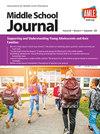“You can’t just make gay people disappear”: Young adolescent LGBTQIA+s’ advice for middle level educators
Q3 Social Sciences
引用次数: 0
Abstract
Abstract Young adolescents who are LGBTQIA+ often encounter hostile experiences while in middle level schools. Researchers conducted semi-structured interviews with 11 young adolescents who are LGBTQIA+ at two middle schools to determine their experiences. Students report the ages at which they realized their gender and sexual identities: Five reveal recognizing their identities before they entered sixth grade. Respondents provide examples of how they are often mistreated and disrespected by fellow students and teachers. Students offer advice to middle level educators for how to protect and support them as they interact with teachers and fellow students. Differences between gender identity and sexual orientation are provided to assist educators in understanding the distinction and its significance. Current sexual and gender identity vocabularies are provided, as is a rationale to avoid labeling anyone who is LGBTQIA+ as “diverse” or with the phrase, “identifies as.” Three types of victimization of adolescents who are LGBTQIA+ that often occur at school are identified: staff-sanctioned victimization, direct victimization, and indirect victimization. The effects of victimization are described as are suggestions for circumventing these behaviors. We offer strategies to help educators identify and address heteronormative beliefs and resultant negative policies. Suggestions are provided for how to create safe and equitable environments in middle level schools for students who are LGBTQIA+."你不能让同性恋者消失":青少年 LGBTQIA+s 给中级教育工作者的建议
摘要 身为 LGBTQIA+ 的青少年在中学就读期间经常会遭遇敌对经历。研究人员对两所中学的 11 名 LGBTQIA+ 青少年进行了半结构式访谈,以了解他们的经历。学生们报告了他们意识到自己性别和性身份的年龄:五名学生透露,他们在进入六年级之前就认识到了自己的身份。受访者举例说明了他们如何经常受到同学和老师的虐待和不尊重。学生们就如何在与老师和同学交往时保护和支持他们向中级教育工作者提出了建议。提供性别认同和性取向之间的区别,以帮助教育工作者了解两者的区别及其意义。提供了当前的性认同和性别认同词汇,以及避免将任何 LGBTQIA+ 人贴上 "多元化 "标签或使用 "认同 "短语的理由。确定了经常在学校发生的 LGBTQIA+ 青少年受害的三种类型:工作人员认可的受害、直接受害和间接受害。我们描述了受害的影响,并提出了规避这些行为的建议。我们提供了一些策略,帮助教育工作者识别和解决异性恋观念以及由此产生的负面政策。我们还就如何在中学为 LGBTQIA+ 学生创造安全、公平的环境提出了建议。
本文章由计算机程序翻译,如有差异,请以英文原文为准。
求助全文
约1分钟内获得全文
求助全文

 求助内容:
求助内容: 应助结果提醒方式:
应助结果提醒方式:


